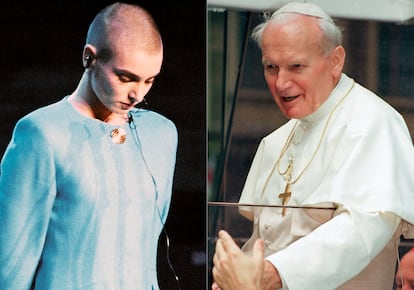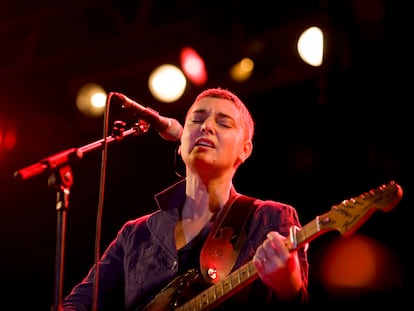For clergy abuse survivors, Sinead O’Connor’s protest that offended so many was brave and prophetic
O’Connor’s protest was prophetic, forecasting the global denomination’s public reckoning that was still to come

In 1992, Sinéad O’Connor destroyed a photo of Pope John Paul II on U.S. national television. The pushback was swift, turning the late Irish singer-songwriter’s protest of sex abuse in the Catholic Church into a career-altering flashpoint.
More than 30 years later, her “Saturday Night Live” performance and its stark collision of popular culture and religious statement is remembered by some as an offensive act of desecration. But for others — including survivors of clergy sex abuse — O’Connor’s protest was prophetic, forecasting the global denomination’s public reckoning that was, at that point, yet to come. O’Connor, 56, died Wednesday.
The SNL moment stunned David Clohessy, a key early member of the Survivors Network of those Abused by Priests. In his 30s at the time, he had only recently recalled the repressed memories of the abuse he suffered. He found O’Connor’s act deeply moving. It was something he and other survivors never thought possible.
That night O’Connor, head shaved and looking straight into the camera, stood alone singing Bob Marley’s song “War” a capella. She finished the final lines, “We know we will win/ We have confidence in the victory/of good over evil,” and then moved an off-screen photo of Pope John Paul II in front of the camera.
Then O’Connor ripped it to pieces. She called out, “Fight the real enemy,” before she threw the scraps to the ground. Clohessy remembers it well.
“We were all just deeply convinced that we would go to our graves without ever seeing any public acknowledgment of the horror and without any kind of validation whatsoever,” Clohessy said. “That’s what made her words so very powerful.”
The ripples it caused
The SNL performance appalled Thomas Plante, a Catholic psychology professor at California’s Santa Clara University, and his wife who is Jewish. Plante was well aware of the issue since he was researching, evaluating and treating clerical sex offenders at the time.
“It is understandable that people would want to make strong statements about their issues with the Catholic Church, but tearing up a picture of the Pope on live TV was way over the top,” Plante said in an email. “Many people feel free to ‘throw the baby out with the bathwater’ when it comes to criticism of the Catholic Church.”
He also noted the prevalence of anti-Catholic hate, especially following the Boston Globe’s 2002 report revealing widespread abuse and cover-up by the church. Plante said the clergy abuse crisis was horrible, but people often fail to recognize that it is a problem of the 20th century and earlier — cases are extremely rare in this century, he said.
“Much progress has been made and current policies and procedures are actually working,” he said.
The quarter-century legacy of John Paul II — then pope, now a saint — has been badly tarnished by evidence he turned a blind eye to abuse even when the Vatican had copiously well-documented cases and even when bishops in the U.S., facing mounting legal liability, begged the Vatican for fast-track ways to defrock abusers in the 1980s.
Vatican officials have long excused John Paul’s attitude by arguing that he had seen first-hand how priests in his native Poland were intentionally discredited with false accusations by Communist authorities, and thus believed any accusations against clerics were mere “calumnies” intended to harm the church.
O’Connor was found unresponsive Wednesday at her home in southeast London. Saddened by her passing, Brenna Moore, a theology professor at Fordham University in New York and a big fan of O’Connor, described her as “a kind of prophetic truth-teller.”
Society, especially in the English-speaking world, is used to men taking on this role, Moore said, but when a woman does it, she’s accused of being crazy and angry. Moore, referencing O’Connor’s memoir, said the singer was more than a rebel with a shaved head.
“She sort of stands in a long line of artists and poets who have a kind of rebellious punk ability to speak truth to power in a very performative way,” Moore said. “She was a profoundly spiritual person, a profound seeker of transcendence and the truth.”
For some, the act was courageous and even wise
Jamie Manson, president of Catholics for Choice, was a teen living on Long Island with her traditional Catholic Italian family in 1992; she recalled just how horrified they were by O’Connor’s protest. But for Manson, who was feeling a call to the priesthood at the time, looked at it more with curiosity.
Manson called O’Connor a visionary, especially given that neither the Irish or U.S. Catholic hierarchy had yet publicly reckoned with the pervasiveness of clergy sex abuse.
“Not many people that we would call prophetic are willing to risk everything, and she was. … And she lost almost everything as a result,” Manson said. “It is very, very scary to challenge the church in a very public way. And it takes enormous bravery and a willingness to be able to let go of everything.”
Clohessy also depicted the 1992 protest as courageous: “I think young people can’t know — and older people to some extent have forgotten — just how extraordinarily powerful the Catholic hierarchy was in those days.”
Invoking the famous Martin Luther King Jr. quote, Clohessy said that “the moral arc of the universe bends toward justice. She’s proof of that. And it bends so slowly — and it bends backwards along the way.”
Attorney Jeff Anderson, who has represented victims of Catholic clergy sex abuse in numerous cases across the U.S., connected with O’Connor around the time of her SNL appearance. In a statement, Anderson called her wise and ahead of her time.
“Sinéad saw predator priests not as a ‘couple bad apples’ but as signs and proof of a deeply corrupt and almost untouchable clerical system,” Anderson said. “It took tremendous courage for her to be one of those early, lonely voices for the voiceless.”
Michael McDonnell, interim executive director of Survivors Network of those Abused by Priests, said O’Connor “wore the anguish of victims of clergy abuse and it seems as though she knew in 1992 the horrors that hadn’t yet been revealed.
“Ultimately,” he said, “she relieved the pain for tens of thousands of victims with rebellion.”
Sign up for our weekly newsletter to get more English-language news coverage from EL PAÍS USA Edition
Tu suscripción se está usando en otro dispositivo
¿Quieres añadir otro usuario a tu suscripción?
Si continúas leyendo en este dispositivo, no se podrá leer en el otro.
FlechaTu suscripción se está usando en otro dispositivo y solo puedes acceder a EL PAÍS desde un dispositivo a la vez.
Si quieres compartir tu cuenta, cambia tu suscripción a la modalidad Premium, así podrás añadir otro usuario. Cada uno accederá con su propia cuenta de email, lo que os permitirá personalizar vuestra experiencia en EL PAÍS.
¿Tienes una suscripción de empresa? Accede aquí para contratar más cuentas.
En el caso de no saber quién está usando tu cuenta, te recomendamos cambiar tu contraseña aquí.
Si decides continuar compartiendo tu cuenta, este mensaje se mostrará en tu dispositivo y en el de la otra persona que está usando tu cuenta de forma indefinida, afectando a tu experiencia de lectura. Puedes consultar aquí los términos y condiciones de la suscripción digital.
More information
Archived In
Últimas noticias
Chris Martin, Taylor Swift, Elijah Wood and other famous wedding ‘crashers’
‘How does it feel to be a failure?’: Elizabeth Berkley’s journey from ‘Showgirls’ ridicule to vindication
The story of the Málaga virus: The code that haunted Google’s cybersecurity center director for 30 years
The impact of Ecuador’s mega-prison: A polluted river, cleared forests and military checkpoints
Most viewed
- Christian Louboutin: ‘Young people don’t want to be like their parents. And if their parents wear sneakers, they’re going to look for something else’
- The low-cost creative revolution: How technology is making art accessible to everyone
- Liset Menéndez de la Prida, neuroscientist: ‘It’s not normal to constantly seek pleasure; it’s important to be bored, to be calm’
- All the effects of gentrification in one corner of Mexico’s Colonia Roma
- December Social Security and SSI payments: Dates, double checks and the 2026 COLA increase










































